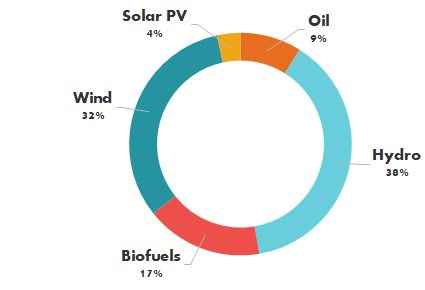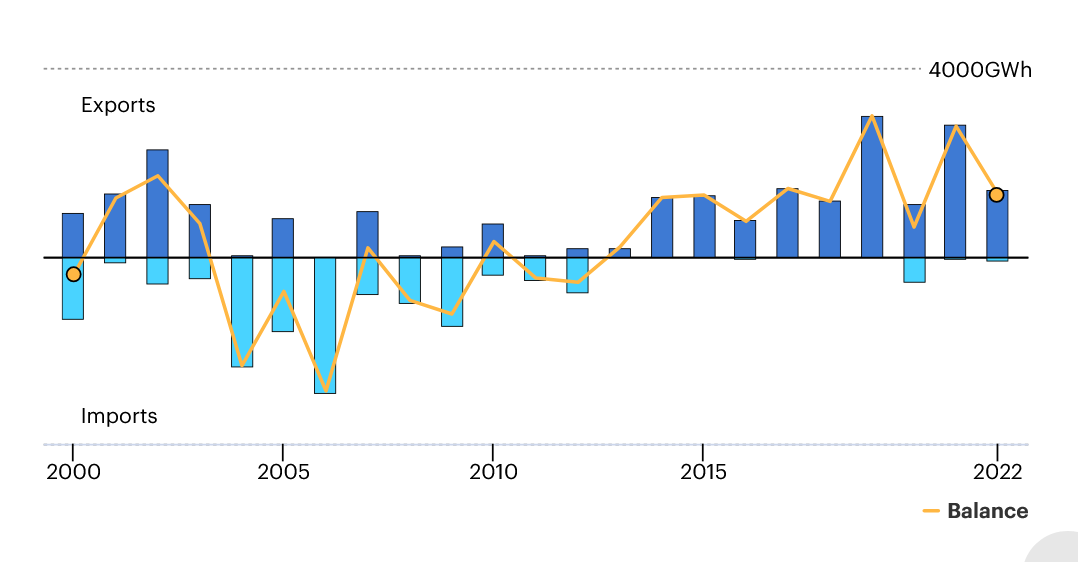A revolution in wind power
Uruguay made a decisive pivot away from oil towards renewable energy before most countries thought such a move would be economically beneficial.
Today, the small South American nation is a global clean energy leader, deriving approximately one-third of its electricity from wind power, two-fifths from hydropower, and cutting its reliance on imported oil for electricity from 50% in 2008 to only 9% today.
Source: IEA 2022, made by author
Uruguay can proudly claim to have one of the cleanest grids in the world — but how did it get here?
A hot, dry and risky planet
In 2008, two shocks hit Uruguay.
First, there was a prolonged drought which caused hydropower generation to drop from 8,000 GWh in 2007 down to 4,500 GWh just a year later.1
Second, oil prices hit a staggeringly high peak of 150 USD/barrel, a level that has not been matched since. As an oil importing nation, Uruguay was in trouble. It was unable to meet consumer electricity demand with the budget it had set out.2
Something had to change.
A never-ending risk
That is when experts in Uruguay conducted extensive modelling which showed that the current state of affairs was unsustainable.
With climate change, hydropower was only going to become more volatile. In fact, SwissRe, one of the world’s largest re-insurers (that is, an insurer of insurance companies), noted that climate change will present a systemic risk for power generation in Uruguay, and in 2023 the country faced a “once-in-century” drought, that led to the declaration of a national emergency.
The other source of risk was a dependency on imported oil. Around half of all electricity generation in 2008 needed imported oil. Oil crises had occurred in the past, and they could re-occur in the future.
Winds of change
At this point, Uruguay was contemplating its options. Nuclear was floated around as an idea but this would require a large initial investment, importing enriched uranium, and timelines that were bound to incur cost overruns and potentially political opposition. These challenges were highlighted by a Uruguayan nuclear physicist, Ramon Gallain.
At the same time, experts in the country were doing their own modelling. Ruben Chaer and Gonzalo Cassaravilla calculated that while electricity from imported oil costs between USD 150-200/MWh, wind power could deliver it for USD 65/MWh, an order of magnitude drop.3
The next steps were clear: ramp up wind power and reduce oil imports.
The necessary conditions
Geographically, Uruguay is largely made up of “uninterrupted grasslands”, making it ideal for wind generation. Farmers received wind turbine rents, making them willing participants in the energy transition.4
The legal system was also amenable to the build-out of transmission infrastructure which would carry wind energy from where it would be generated to where it would be needed. Specifically, the state power company, UTE, could acquire lands in an expedited manner in the name of public interest.5
Finally, in 2007 Uruguay received a USD 1 million grant from the Global Environment Facility and put up USD 6 million of its own to fund a new “Uruguay Wind Energy Program”.
This set the stage for what would follow: in 2009, Uruguay began to run auctions in which wind companies from around the world competed to offer the cheapest renewable energy to the country. Power purchase agreements for 20 years were offered to incentivise entry by wind developers.
From insecurity to security
Before the uptake of wind energy, Uruguay was a net importer of electricity from neighbouring countries. But this changed once the wind turbines started generating electricity. Uruguay went from being a net importer of electricity to an exporter, helping fill government coffers, and creating even more goodwill around the energy transition.
On the labour market side, it is estimated that 50,000 new jobs were created in the process, which is a large number for such a small nation.
Source: IEA
What’s next?
According to expert, Ruben Chaer, Uruguay will move into solar energy next and then proceed to grid-scale batteries given the dramatic decline in costs. There is also a pivot to electrify transport to further reduce dependence on imported oil.
The takeaways
Uruguay’s transition shows that renewable energy can actually reduce systemic risk. Uruguay did exactly what Kenya and Iceland did in response to oil price shocks: it found a secure, clean and domestistically available source of electricity.
This also underscores the power of prices - increases in oil price have catalysed large-scale transitions, but relying solely on geopolitical shocks to fix climate change is not a sound strategy. We need to move full speed ahead on taxing polluting fuels systematically across the world.
Uruguay shows that even a small nation in the Southern hemisphere can be a world-class leader in the energy technologies of the 21st century.
IEA data. https://www.iea.org/countries/uruguay/electricity
Sugandha Srivastav’s interview with Ruben Chaer, Institute of Electrical Engineering, University of the República Oriental del Uruguay
Ibid.
Ibid.
Ibid






Great article. very inspiring to take action. not only at the country level but also if individuals understand the impact, they can also follow the same.
Excellent read. A lesson in taking initiatives